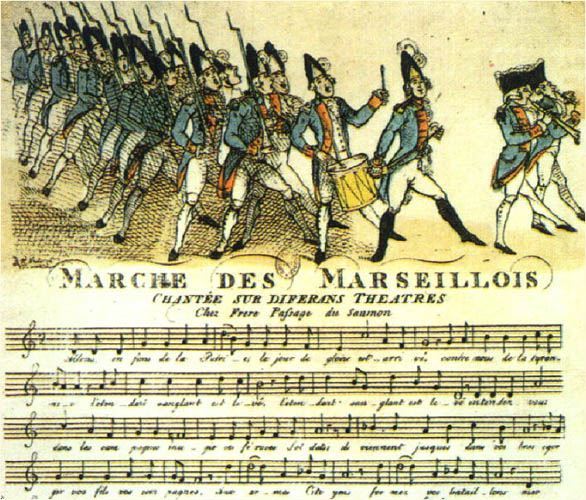|
On 19 June 1792, the Jacobin club of Marseilles wrote to Jerome Petion, the mayor of Paris warning him that the King, with his corrupt civil list, was a threat to French Liberty, and that they were ready to come and lend a hand. A few days later, a deputation of 500 Marseillais set off for Paris on foot – over 700 km. Their leader, a captain from Montpellier, sang for them a war song celebrating the Revolution, written by Rouget de Lisle. On 30 July, the Marseillais entered Paris singing that same song. One can only imagine what 500 hungry, thirsty, and possibly ill soldiers suddenly entering the Capital must have been like. And of course, they had come for a reason, to confront the King and defend Liberty. So it’s no surprise perhaps that on 10 August, they took part in the massacre of the Swiss guards in the Tuileries. But before they did, 400 of them made a stop at the Hotel des Monnaies, the home of the Condorcets. The building is not small, nonetheless, making space for, and serving 400 scruffy soldiers must have been a challenge. But if it was, Sophie met it well. According to her biographer, Guillois, she was the ‘Queen of the party’, and that: she charmed them so well that she could have, had the Gironde listened to her, saved, with the help of the Marseillais, Coutnry and Liberty.
0 Comments
On the afternoon of 2 September 1792, the Tocsin was rung, and and canon was shot as an alarm. Word was out that France had lost Verdun, and the traitors to the republic were blamed - they must have spread intelligence. Who were the traitors? Mostly two kinds: the aristocrats, and the priests who had refused to pledge allegiance to the new civic religion, known as the refractory priests. But most of those were in prison. Manon reports the following anecdote: her husband was then minister of the interior, and one of his deputies came to alert the Paris Commune that some of the prisoners might be at risk. Danton replied testily: "I don't give a fuck for the prisoners or what happens to them!" (Portrait de Danton). There was indeed cause for worry: the last time the tocsin was rung and the canon shot was the 10 August, when the Parisians stormed the Tuileries, where the King and his family was held, and massacred the Swiss guards who were there for their protection. The King and Queen were now at the Temple prison, and quite safe for the time being. But the Swiss guards that survived, and some of the nobles of their entourage, such as the Princess of Lamballe, were in the Paris prisons. By the evening of 5 September, most of them were dead. The British Caricaturist James Gilray published the following picture of a sans-culotte (here depicted literally without trousers!) family eating the flesh of their victims after a day of murders. Unfortunately the caricature was not as far from the truth as it might have been, as Manon reports to a friend a few days later. "If you knew the horrible details of these expeditions! Women are brutally raped, before these tigers tear them apart, entrails are worn as ribbons, human flesh eaten, still bleeding! You know my enthusiasm for the Revolution, well, I am ashamed of it. It has been stained by scelerats, it has become ugly!|"| (letter to Bancal, 9 September 1792)." This episode marked a turn in the Revolution. Those who had been critical of the Commune, or Robespierre, Danton, and Marat - "My friend Danton leads all, Robespierre is his dummy, Marat holds his torch and his knife." - were now reluctant to have anything to do with them. By January, Roland had handed in his demission from the ministry, on 1 June, his wife was arrested, and on 2 June a decree for the arrest of the Girondins was issued. By November, all were dead. "The whole of Paris let it happen... the whole of Paris is damned in my eyes, and I no longer hope that liberty may take root amongst such cowards, insensible to the worst outrages inflicted on nature and humanity, cold spectators of attacks that could easily have been prevented by fifty armed men." (Memoires) |
About
This is where I live blog about my new book project, an intellectual biography of three French Revolutionary women philosophers. Categories
All
Archives
November 2022
|





 RSS Feed
RSS Feed